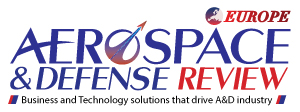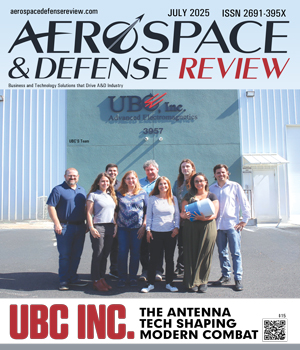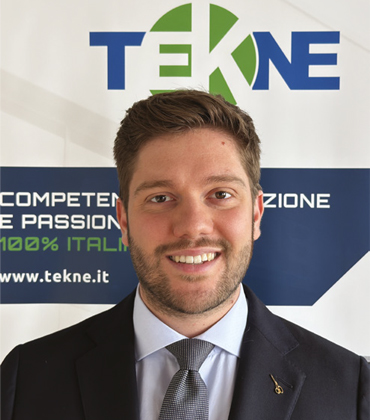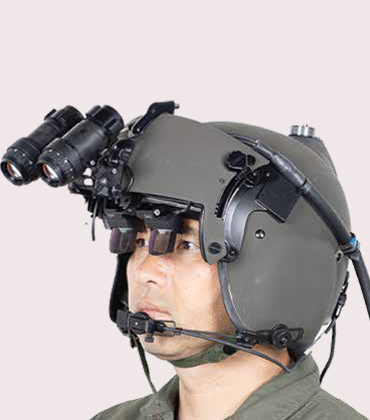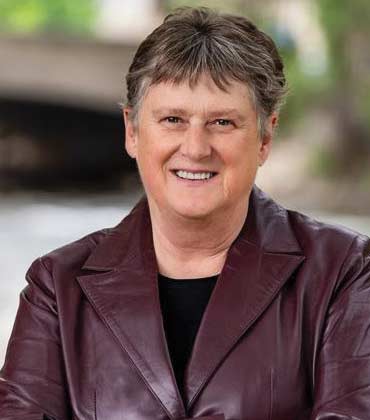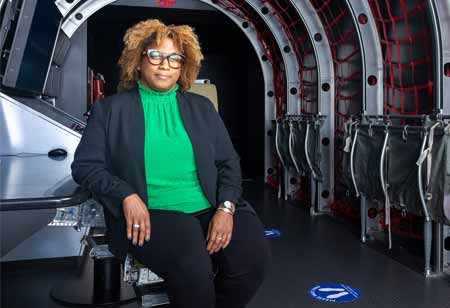THANK YOU FOR SUBSCRIBING
As global tensions rise and defense budgets hit record highs, militaries are shifting focus from firepower to foresight. As Gen. Watson of the U.S. Marines warned recently, defenders must be “relevant when the conflict arises,” or it will be too late. Achieving that level of combat readiness requires training technology that can accurately replicate enemy tactics to keep trainees on their toes. Here, precision radar-simulating antennas— like those engineered by UBC Inc—become mission-critical. Founded in 1980 by Pat and Rebecca Crane, this Florida-based, Hispanic-woman-owned company has become an indispensable supplier for the U.S. military, preparing warfighters to detect, respond to and outmaneuver today’s increasingly sophisticated threats. UBC’s signature innovation is its Cassegrain twist reflector antenna, a highly agile, lightweight system that allows for wide-angle scanning at extremely high speeds. “Our solution allows us to provide a scanning antenna without some of the cumbersome and expensive electromagnetic pieces like a rotary joint that would go along with a standard Cassegrain antenna,” says Charles Sleeper, president and CEO. In fact, very few companies around the world have mastered the technology behind UBC’s Cassegrain twist reflector antenna. The system features a Cassegrain reflector at the antenna’s front, which reflects the transmitted electromagnetic waveform onto a specially designed twist plate. This plate induces a phase shift that aligns, or co-polarizes, the signal with the main reflector, enabling efficient transmission into free space. Its innovative design achieves beam steering solely by adjusting the lightweight twist plate. The plate’s low inertia helps the system scan rapidly and with high positional accuracy without relying on heavier, slower mechanical components. UBC’s antennas can now deliver fast, precise performance that is ideal for simulating complex radar threats in dynamic environments.
Vehicles & Electronic Systems Manufacturer of the Year 2025
Tekne has established itself as a key player in the defense sector, blending its Italian heritage of engineering excellence and dynamic leadership to deliver cutting-edge technology for the operator. A family-owned company rooted in the Abruzzo region of Italy, where its headquarters is located, Tekne also maintains a smaller presence within Italy’s famed Motor Valley, allowing it to further leverage the engineering experience and forward-thinking approach typical of the area. The company is known for its unique capability to unify advanced electronics and special-purpose vehicle engineering under one roof to deliver fully integrated, mission-ready, high-performance systems with unmatched speed and flexibility. Its core strength lies in the depth of expertise in its engineering department, with roots in the division it acquired from Thales in 2016, that enables it to develop proprietary radio frequency (RF) technologies. These in-house solutions include systems for offensive and defensive EW, counter-IED, counter-UAS and secure telecommunications. Tekne’s communications and EW systems have been proven by operators in the field, deployed in extreme climates, including active conflict zones, demonstrating unmatched reliability and adaptability. One key differentiator is its stealth-reactive anti-drone platform, designed to remain electronically silent until a threat is detected and then respond with decisive force. These modular EW systems are based on proprietary jamming technology that can be integrated with radar, electro-optical and acoustic sensors as well as layered countermeasures, including kinetic and directed-energy responses. Built for rapid engagement and minimal exposure, they offer agile protection in contested airspace. “We are capable of delivering a fully integrated product that incorporates our proprietary technology, spanning both vehicular and electronic systems,” says Davide D’Arrezzo, sales & marketing. Tekne’s proprietary 4x4 multipurpose and armored vehicles, such as the Graelion and Praetorium, are designed and manufactured in-house, enabling a philosophy of cyber protection by design and seamless integration with mission electronics. This vertical integration allows Tekne to rapidly tailor solutions to address evolving battlefield conditions for the military and a range of civil protection requirements. Custom Defense Solutions Built for Agility Operating more like a special forces partner than a traditional supplier, Tekne’s compact, flexible structure enables rapid prototyping, accelerated development and close client collaboration. This model has earned the trust of elite forces and critical infrastructure agencies across Europe and beyond. Most systems originate from specific mission needs and are engineered from the ground up, not retrofitted from generic platforms.
Top Cutting Edge Coating Solution 2025
America’s defense sector is stuck in a toxic relationship with chrome. For decades, chromium plating has been used inside gun barrels to reduce wear. But it erodes quickly under heavy fire, degrades accuracy, and leaves a toxic legacy behind. When gun barrels fail, replacements take many months. Warfighters are left waiting while contractors continue supplying the same outdated technology. Despite mounting failures and billions wasted on replacements, the cycle continues—because broken barrels mean more business. One cannot win a war with damaged barrels. Yet that is the reality on the ground, where outdated coatings put missions at risk and troops under pressure. What the industry needs isn’t a tweak—it needs a paradigm shift. Paradigm Shift Technologies delivers exactly that. Its patented Enhanced Physical Vapor Deposition (EPVD®) technology replaces chrome with a field-proven coating that dramatically extends barrel life, sharpens accuracy, and eliminates toxic materials. It’s not a patch—it’s a transformation. A New Defense Against Wear, Erosion, and Inaccuracy Paradigm Shift Technologies’ EPVD® technology isn’t hypothetical—it’s field-proven. Validated by the U.S. Navy and Air Force, as well as the Canadian Army, it’s already pushing weapons systems beyond current limits: extending barrel life, increasing precision and rate of fire, and slashing the logistical burden tied to frequent replacements. As U.S. Army General Darryl Williams said at the Fire Symposium, each howitzer deployed in Ukraine has needed 10 to 15 barrel replacements, putting an unsustainable burden on operational readiness and frontline effectiveness. This underscores that, despite advances in ammunition, barrel materials, and thermal management, weapons still falter under the same core flaw: a coating that can’t keep up. The military already recognizes the problem, as evidenced by the fact that sniper rifles are never chrome-plated, specifically because chrome compromises precision. This exception highlights Paradigm Shift Technologies’ argument: if accuracy is important enough to eliminate chrome from sniper rifles, why should it be acceptable for other weapon systems?
Top Headworn Display Systems Solution 2025
Augmented Reality (AR) delivered through head-mounted displays (HMDs) is transforming rotary-wing aviation, making them significantly safer. Considering its potential, the technology’s evolution has been unexpectedly slow until recently. The development of this critical defense solution was largely in the hands of major contractors reliant on legacy systems and outsourced components, limiting innovation and domestic control. Vision Products, a U.S.-based small business, is shifting the paradigm in military AR by doing what few can—building high-performance HMDs entirely from U.S.-sourced components in a bold break from industry norms. This isn’t a marketing gimmick but a strategic design decision rooted in the trust and independence that domestic control enables, something offshore sourcing can’t match. The company specializes in developing advanced electro-optical systems that remain several steps ahead of the competition. Much of this edge comes from the industry’s overreliance on technologies like waveguides and analog sensors—waveguides are often fragile and produce blurry imagery, while analog sensors limit the integration and fusion of advanced digital data streams. Vision Products takes a different path. Its systems are built to be rugged and digitally native, pioneering capabilities in night vision HMDs and digital night vision goggles (NVGs). The imagery they generate can be recorded, enhanced with AI/ ML, fused with thermal sensors, and shared in real-time with teammates and command centers—dramatically increasing situational awareness. These capabilities put the company at the forefront in the field of view (FOV), resolution, contrast, sensor sophistication, and packaging to deliver real-world impact, particularly in nighttime or degraded visual environments (DVEs) where pilots lose natural visibility due to snow, sand, dust, fog, smoke or darkness. “Instead of forcing helicopter pilots to look down at the cockpit, our system projects vital information like terrain, speed, altitude and location, as well as sensor video, directly into their line of sight in a wide, high-resolution field of view, effectively mitigating DVEs,” says Michael Browne, Ph.D., President of Vision Products.
Top Satellite Solutions Provider 2025
NAVSYS Corporation
Offering Commercial PNT for a Resilient Future
Dr. Alison Brown, President and CEO
In the rapidly evolving world of positioning, navigation, and timing (PNT), few companies stand as boldly at the crossroads of innovation and necessity as NAVSYS Corporation. Under the leadership of President and CEO Dr. Alison Brown, the company has established itself as a pioneer of novel technological frameworks and a critical voice challenging entrenched perceptions about the future of PNT—particularly for defense and critical infrastructure resilience. “Founded on a bedrock of engineering expertise and system-level innovation, we have long worked at the interface between commercial technology and national security,” says Dr. Brown. With growing interest from the U.S. Department of Defense (DoD) in commercial alternatives for resilient PNT, the company’s signature platform—PNT as a Service (PNTaaS)—may be the disruptive solution the sector has been awaiting. Technically Superior, Financially and Logistically Pragmatic The U.S. Space Force’s Commercial Space Strategy highlights PNT as a key area for commercial integration to improve resilience. Despite this, government funding has lagged, favoring only select companies like Xona and Iridium, while others—such as NAVSYS—remain underfunded despite offering aligned proposals. Initiatives like AFRL’s CAPR and the SpaceWERX AltPNT Challenge are helping bridge this gap. However, skepticism persists, with officials such as SSC’s Charlotte Gerhart claiming that true commercial PNT alternatives don’t yet exist. This view contrasts with the Defense Science Board’s recommendation for the strategic adoption of commercial PNT—a position now weakened in USSF plans. NAVSYS, however, stands firm in its belief that its PNTaaS platform represents a technically superior and financially and logistically pragmatic alternative. While others propose launching entire satellite constellations to deliver PNT capabilities, NAVSYS sidesteps this expensive and time-consuming process by leveraging existing infrastructure. The PNTaaS model transforms current satellite communication broadcasts—from platforms such as Eutelsat, OneWeb, Intelsat, Viasat, and SES—into PNT signals through software-defined data services and ground-based monitoring hardware. This approach significantly reduces capital expenditure and enables near-global scalability without requiring a proprietary satellite network.
Top Aircraft Accident Investigation Service 2025
The Last Word in Aviation Safety Expertise he National Transportation Safety Board (NTSB) is widely considered the gold standard for investigating major aviation accidents and improving public safety. As a federal agency, the NTSB plays a vital role in handling large scale incidents and producing findings that inform national policy and regulation across air, rail, and marine transportation. However, its jurisdiction is not all-encompassing, and its investigations often take weeks or even months to mobilize—especially in cases involving urgent or complex issues. Not every organization can afford to wait for lengthy, government led investigations. This is where DVI Aviation steps in. DVI Aviation has become a trusted partner to aerospace manufacturers, airlines, defense contractors, MROs (Maintenance, Repair, and Overhaul providers), and operators who require timely, in-depth analyses of accidents, component failures, and unexplained anomalies. Often regarded as the private-sector counterpart to the NTSB, the company delivers rapid forensic investigations and expert analysis precisely when they are needed most. Its services not only help resolve safety issues but also inform legal strategies and prevent future failures. A Comprehensive and Confidential Approach to Forensic Investigations “Our independent and unbiased investigations are thorough, science-driven, and tailored to each client’s distinct needs— whether resolving a safety issue, informing legal strategy, or preventing future failures,” says Dr. Steven J. Meyers, President and Chief Scientist at DVI Aviation. Unlike the NTSB—whose findings are publicly disclosed and can take months to finalize—DVI Aviation offers a faster, more flexible alternative. Its team mobilizes senior experts within hours—not weeks—to investigate aerospace incidents across a broad spectrum, from aircraft and UAS/ drone failures to spacecraft mishaps and ground-support equipment breakdowns. The company provides end-to-end failure analysis, including on-site field investigations, wreckage and flight path reconstruction, metallurgical and forensic laboratory services, aircraft systems analysis, structural assessments, and expert testimony.
CXO INSIGHTS

Designing Strategies for Innovating Supply Chain Management
Adrian Quinones, Director of Supply Chain, Curtiss-Wright Corporation

Insights into Streamlining Flight Operations
Carrie Haase, Chief Pilot, Aurora Flight Sciences

Airport Management Innovations: Navigating Challenges Effectively
Abe Weber, Airport Director, Appleton International Airport

Unveiling Automated Maintenance in Aviation
Robert DeGrie, Director of Technical Services (Aircraft Engineering), Amerijet International

Warfare Reimagined: The Next Generation of Marine Corps Training
Marcus Reynolds, Program Manager, Training Systems, Marine Corps Systems Command

Wheels Up: Inside the Relentless World of AOG
Mark Finger, Manager – AOG Response, Delta Air Lines
IN FOCUS
EDITORIAL
At the Crossroads of Innovation from Ground to Space
A new era defined by speed, intelligence, precision and digitalization is driving the transformation of the aerospace and defense industry. From the boundaries of Earth’s atmosphere to the complexities of global security, today’s top industry players are transforming traditional defense systems and reimagining the infrastructure of air and space in unprecedented ways. From hybrid-electric engines to reusable orbital platforms, tech advancements are driving a transformation in commercial and military aviation. Leading aerospace companies are developing cutting-edge, low emission propulsion systems, unmanned aerial systems and space surveillance tools that deliver greater efficiency and unmatched performance. Space technology is also undergoing rapid innovation, with modular satellite constellations, AI-enabled orbital surveillance systems and reusable launch vehicles coming to the fore. Simultaneously, defense technology providers are integrating AI, machine learning and quantum computing into mission-critical platforms for enhanced performance and faster threat detection and mitigation. Advanced defense systems with software-defined architecture are being equipped with intelligent sensors for more effective surveillance and high-tech tools for facilitating encrypted communications. This edition of Aerospace and Defense Review presents expert opinions and viewpoints on the latest developments shaping the future of aviation and national security. It features insights from Paul Guerrier, manufacturing engineering manager at Moog Inc. [NYSE: MOG-A]. He highlights the strong demand for improving system architecture from aerospace companies seeking to achieve zero defects in design and functionality. He discusses how adopting AI technologies can help reach this goal by augmenting the manufacturing process. Candace Givens, Sector Vice President Mission Assurance at Northrop Grumman, discusses a renaissance in space exploration, ushered in by rapid innovation and advancements in technologies that are making space mission launches seamless and more affordable. We hope this edition gives you in-depth insights into the how leading players in the aerospace and defense space are embracing next-generation capabilities that push the boundaries of flight, space exploration and national security.

However, if you would like to share the information in this article, you may use the link below:
https://www.aerospacedefenserevieweurope.com/edition/july-2025-36.html
